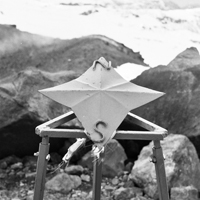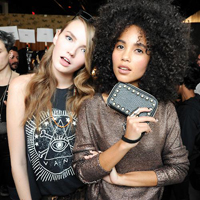In our Spring Study 2008, it’s quite revealing just how much the marketplace has changed in terms of top stores for fashion shopping. When asked, “What store do you like to shop in most?”overall, the #1 top store is Hot Topic at 10.8% followed by Pac Sun at 9%. However what’s interesting to note overall, are that the top percentages have all decreased in general, as more niche stores and boutiques and even large big-box retailers have moved into being top stores. For example, Hot Topic was the #1 store that 13-25-year-olds like to shop in the most at 18.5% last year, followed by Pac Sun at 14.6%. This is significant to note because there are other stores that continue to move up and are taking a percentage of marketshare such as Online Retailer now being 3rd overall at 7.7%. This is up from 4.7% from last year and one of the most significant changes in fashion store preferences to note. Other significant changes are that Forever 21 has surpassed Target now at 6.8% or 4th overall, followed by Target at 6.2% which has dropped slightly. Other top stores to note are Zumiez at 6.1% which is down from 6.8% then American Apparel at 5.8%, which has surpassed American Eagle which is at American Eagle 4.5%, down from at 6%, followed by Hollister at 4.2% tied with H&M. As noted last year, we anticipate Online Retailer to continue increasing, as well as American Apparel, and H&M. Look also for Local thrift/Vintage to continue to be strong, which it is at 2.7%.
By gender the biggest change in the last 6 months is that males now rank Online Retailer as the #1 shop they like to shop in at 13.1% followed by Hot Topic at 12.1%, Pac Sun at 10.5%, then Zumiez at 9%. This is a significant change in shopping preferences in general. For females, the top store locations include Forever 21 at 10.4%, followed by Hot Topic at 10%, Pac Sun at 8%, Target at 6.6%, followed closely by American Apparel at 6.5%. Overall, there have been significant shifts in favorite stores by gender, with Forever 21 and American Apparel increasing for females and Online Retailer and Hot Topic among males. As we noted last Fall, 2007, one reason why Hot Topic remains high is because of the increase in percentages among males in the last year months.
Hot Topic, once considered Gothic and punk in nature has been a part of the youth landscape because they are stylish in an angst-riddled way and appeal to the fascination of misunderstood young people. Hot Topic is also extremely popular because of its key accessory collections, music-branded T-shirts wallets, chains, leggings, and now, a wider range of sneakers. In addition, Hot Topic, like Urban Outfitters in some locations, offer up band brands, especially in T-shirts, which are extremely popular among youth culture. It is also a misnomer to assume that those who shop in Hot Topic do not shop in PacSun, as we’ve also been asked. They can very likely be the same person, but with a different style for a different day. Forever 21 is greatly admired by females and males for example because of its fast-fashion styles at inexpensive prices. Like H&M, American Eagle, Hollister, Urban Outfitters, and American Apparel, Forever 21 which is a store is often also named as the favorite brand, blurring the line between fashion labels and the actual store names. This is an important trait among youth culture whereby some fashion brands and stores are completely intermixed rather than naming, for example, “We the People” as a favorite brand which is carried in Urban Outfitters, rather than saying Urban Outfitters, as if it’s a fashion brand. This is a similar trait to what we see with Uniqlo in the Japan Youth Culture Study. You also see this with Target with females -which has increased for both genders. Local thrift has increased mainly because of the increase in males now shopping Local thrift rather than a significant increase in females who already shopped Local thrift.
By age groups, there are several correlations. The younger the age group the higher the preferences percentages for Hot Topic, peaking among 13-14-year-olds at 24.1%. It tends to drop at 18. Pac Sun is also strong among 13-14-year-olds but remains high up to 20 where it drops significantly. Online Retailer has a direct correlation now by age groups in that the younger the demographic, the higher the percentages that say Online Retailer. While it is often thought that targeting young people online isn’t as vital if they don’t have credit cards yet, despite this hang-up, many young people prefer to shop online -even if this means they are doing their research online and actually purchasing in stores. Also, many young people figure out a way to actually buy online with a parent’s credit card.
Other trends to note by age is how Forever 21 peaks among 18-20-year-olds at 8.4%, and Target among 18-20-year-olds at 8.5%, then 21-25-year-olds at 21-25-year-olds. American Apparel has a strong following among 15-17-year-olds peaking at 7%. Zumiez is also interesting in that it tends to have high percentages across a broad range of age groups, similar to H&M. Hollister, in the past year, has moved younger with higher percentages among younger age groups. This is also true of Urban Outfitters with higher percentages among 15-17-year-olds.
As we’ve seen in our past North American help site and European Youth Culture Studies–specifically in the past 4 years -there’s been a growing influence and demand in youth culture markets for fashion that’s quick, affordable, easily changed, and allows young people the ability to move on to the next thing without breaking their bank. Fast fashion trends however, do not mean that young people are only into cheap items; the concept is usually paired with spending a significant portion of one’s disposable income buying specific pieces of coveted glamour, particularly denim, footwear, T-shirts, and specific key electronics such as iPods and iPhones, Sidekicks, or specific Video Cameras. “


